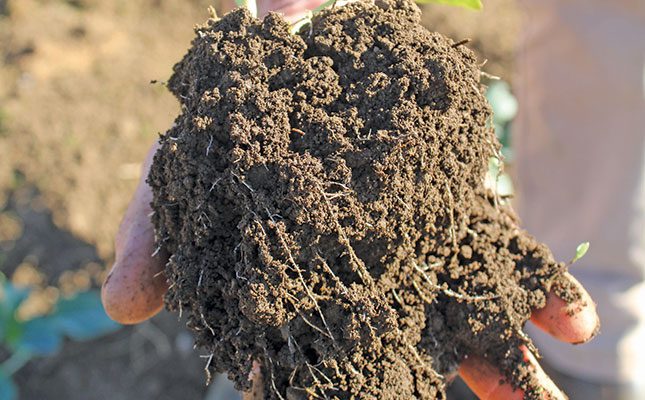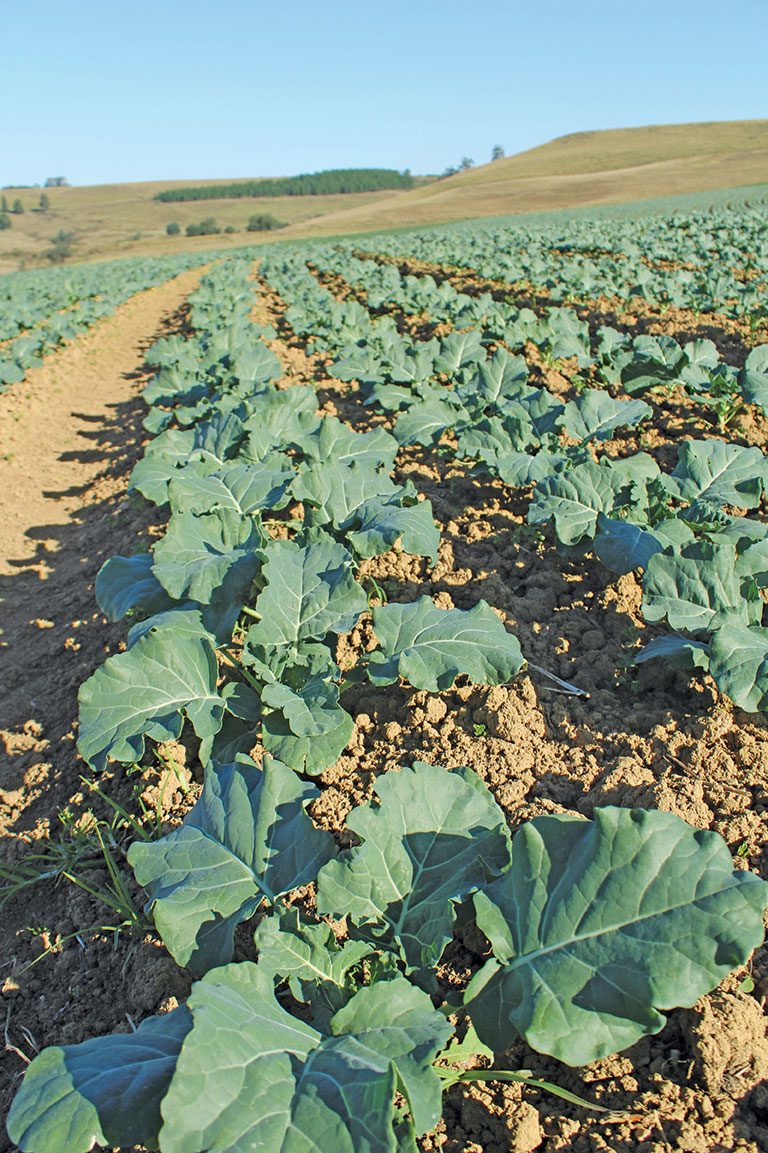
Photo: Lindi Botha
In a world where food availability has risen substantially, why do we still face such a high level of malnutrition?
And how is it possible that we see both obesity and malnutrition in the same person? The answer lies in the nutrient density – or lack thereof – of our foods.
READ The Importance of Soil Health
The green revolution brought about many advances in agricultural practices that resulted in substantially bigger yields. But nutrient levels have for the most part not been maintained, leading to a diet of abundant calories but a deficit of nutrients.

Consumers today have to increasingly rely on pharmaceutical vitamins to get their daily dose of vitamins and minerals since the food they eat does not provide it.
Cathy Burns, CEO of the International Fresh Produce Association, says it’s becoming ever clearer that the solution to our health challenges is not found in the pharm but on the farm.
She notes that among the lessons learnt from the COVID-19 pandemic is the connection between what we eat and how we feel. “People have finally figured out we cannot medicate our way out of diseases and ailments.”
In this regard, agriculturalists have also started figuring out that food crops can’t be ‘medicated’ out of disease and ailments either. Plants need as much of a healthy environment, with top-quality food to thrive as humans do.
University of Washington geomorphologist David Montgomery, who co-authored What your food ate: how to heal our land and reclaim our health, recently stated at the Alltech ONE conference held in Kentucky, US, that soil health is our health.
“There is no shortage of opinions about what we should eat. People argue endlessly over whether we should eat less meat, more meat, no meat, or meat that isn’t meat. What’s typically missing from the framing of dietary choices is how we grow what we eat. The way we raise our crops and livestock proves as important as what we choose to eat.”
Sick soils
Montgomery says modern farming practices, including tillage and the overuse of commercial fertilisers, have disrupted the necessary, healthy symbiosis between plants and the soil.
“Cultivation practices also shape the types and amounts of health-promoting minerals, fats and phytochemicals in our crops, which are transferred to us through the foods we eat.
“In general, we don’t think about a plant having a diet, when, in fact, they do. Plants absorb a myriad elements from the soil which we can consider to be their food, and how we feed them — the ‘diet’ we present them with — will reflect directly in the final outcome.”
Understanding and improving these connections could have profound implications for the food we eat and how we grow it, both now and in the future.
Currently, most farming operations are intensely focused on increasing yields, since food security and a farmer’s profitability are at stake.
This means macro nutrients like nitrogen, phosphorous and potassium feature predominantly in fertiliser mixes as they maximise yields.
For the most part, this masks the true fertility of the soil, and leads to a disregard for building soil health through the improvement of organic matter and fostering soil biological activity that ensures strong root development, plant growth and crop productivity.
READ Contaminants threatening the health of soil and water
Montgomery points to research done by the UN which concludes that a significantly large portion of the world’s soil could be classified as “sick” if we thought about soil as a living ecosystem having health.
According to the UN’s map of global soil degradation, most of the world’s agricultural soils are listed as “degraded” or “very degraded”.
Furthermore, the UN estimates that around a third of the world’s farmland soils have been degraded to the point that their lower quality could have a profound impact on their agricultural productivity.
The UN projects that the world is losing around 0,3% of its ability to produce food every year due to soil erosion and the degradation of organic matter. Simply put, soils are too sick to function properly.
Montgomery puts this statistic in perspective: “0,3% doesn’t sound like a really large number on an annual basis, but if you play that out over the rest of this century, it adds up to degrading another third of the world’s farmland in this time interval. As the world population continuously grows, that is something that we can’t afford.”
Nurturing the soil also provides a buffer against a changing climate, something that is vital to keep feeding the world amid increasing weather severity.
Christian Giesel, head of marketing at Syngenta South Africa, says that soil health is a major part of the answer to how we deal with climate change, soil erosion and biodiversity loss.
“You can only play the hand you have been dealt, and in South Africa that hand is soils with a very low organic content. Soils in the high yield-potential Wesselsbron area in the Free State, for example, have an organic content of less than 0,5%. Compared to the 4% to 6% organic content found in Illinois in the US, we practically farm in a desert,” he says.
Bringing life back to the soil
South Africa’s farmers have therefore been quick to adopt regenerative agriculture practices, which Giesel notes builds organic content in the soil, preventing erosion caused by wind and flooding.
The added bonus is that such cultivation practices also boost the nutrient content of crops.

“Regenerative farming practices can rebuild soil health, bringing life back to the ground and fostering microorganisms’ communities, as well as their synergistic relationships with plants. These benefits can, in turn, suffuse the soil, the rhizosphere, the plants and the crops they grow with the elements they require in order to thrive, such as macro- and micronutrients, minerals and phytochemicals.”
The result is crops that require fewer applications of synthetic fertilisers and crop protection chemicals.
This is especially important since there is mounting evidence that a combination of inputs has a detrimental effect on plant health and the nutrient content of our food.
University of Lincoln, UK, agronomist Leonidas Rempelos in 2021 reviewed previous studies on the health benefits of conventional and organically grown food.
He notes that all evidence points to the many “innovations” introduced as part of the green revolution as having negative effects on both crop health and the nutritional quality and safety of crops.
READ Regenerative farming: can producers afford not to make the change?
“Specifically, there is now substantial evidence that the use of monoculture and short rotations increases crop species-specific weed, pest and disease pressure, which inevitably leads to greater dependence on synthetic chemical pesticides, higher pesticide residues being present in crops, and a greater risk of Fusarium infection and mycotoxin contamination of cereal grains,” he says.
Rempelos’s research shows that mineral phosphorus fertiliser can reduce vital mycorrhizal development on roots, which then negatively affects mineral micronutrient uptake and resistance against soil-borne diseases.
Cadmium concentrations in crops are also increased as a result. “Mineral nitrogen fertiliser is associated with a reduction in crop resistance, lower concentrations of nutritionally desirable phenolics and other resistance-related phytochemicals and antioxidants in crops. Synthetic chemical pesticides on the other hand are responsible for chronic dietary pesticide exposure.”
Building health
The debate surrounding healthy diets often centres on organic versus conventionally grown produce.
And while studies do prove the former to carry fewer pesticide residues, Montgomery notes that when looking at nutritional value, there are far more aspects to consider. Many of these are neglected, but all point to soil health.
“Organic farming tends to enhance soil health and conventional practices degrade it, but relying on tillage for weed control in both instances degrades soil organic matter and can disrupt soil life in ways that reduce crop mineral uptake and phytochemical production. Conversely, microbial inoculants, compost and mulch that build soil organic matter can increase crop micronutrient and phytochemical content on both conventional and organic farms.”
Montgomery says that while creating quantitative soil health indices remains challenging due to varying regional controls on soil properties and life, advocating for farming practices that promote soil health is increasingly seen as central to developing healthy diets.
This includes regenerative agriculture or any cultivation practices that promote microbial activity in the soil.
A 14-year French study published in the journal Agronomy for sustainable development in 2014, tracked the response of soil life to both conventional but conservation agriculture practices, and organic farming practices.
Both the fields were ploughed three out of every four years, with the conservation agriculture system using no-till methods and grass cover crops, applying pesticides only upon exceeding an economic damage threshold.
The abundance of soil life increased under both systems, with visible increases in earthworms and arthropods. Microorganisms (bacteria and fungi) increased by 30% to 70%.
While conservation agriculture practices increased soil life across the board, organic practices mainly increased bacteria and earthworm populations.
Vitamin levels affected
Since the early 1940s, studies have shown that the nutrient density of food is significantly altered through plant nutrition. A 1949 study found that the highest micronutrient values came from crops receiving the least chemical fertiliser.
The study, published in the Soil Science Society of America Journal, looked at the mineral content of five vegetables (cabbage, lettuce, snap beans, spinach, and tomatoes) grown in 10 states across the US, controlled for different crop varieties, to document regional trends and underlying differences in fertilisation regimes.
More recently, a systematic 1993 review conducted by the Institute of Plant Science at the Swiss Federal Institute of Technology in Switzerland, found that synthetic nitrogen fertilisers significantly influence the vitamin content of plants.
READ How natural fertilisers can benefit farmers
This global review found substantial evidence that typical high rates of nitrogen fertiliser use greatly decreased the vitamin C content of fruits and vegetables that account for major sources in human diets.
Although the magnitude of the vitamin C loss varied for different crops, the decrease was significant, with reported reductions of up to 34% in cabbage and 50% in fruit. Nitrogen fertilisers also reduced levels of vitamin E.
And while nitrogen fertilisers were found to generally increase the protein and nitrate content of crops, the combination of reduced vitamin C content and increased nitrate content is particularly problematic for human health because vitamin C inhibits the digestive production of carcinogenic compounds from nitrate.
An ongoing study at the Rodale Institute confirms the earlier findings: since 1981 it has grown the same crops in side-by-side plots in a field-scale comparison of organic and conventional practices.
By 2003, soil organic matter and nitrogen levels had significantly increased on the organic plots, but not on the conventional plots.
On average, oats from the organic system had roughly a third higher mineral content, ranging from 7% more potassium to 74% more boron, with 23% more iron and 40% more zinc.
Vegetables grown under the two systems in 2005 also had large differences in total antioxidant and vitamin C levels. Organically grown tomatoes and jalapeno peppers, respectively, had 36% and 18% more vitamin C.
Organic carrots had 29% higher total antioxidant levels. A little over a decade into this experiment the conventionally managed plots had lower biological activity than the cover cropped organic soils, which had increased in carbon over the course of the field trials.
Simply put, the healthier soils with more soil life were producing more nutrient-dense crops.
In assessing the nutrient value of produce, Montgomery highlights an important aspect to consider: macronutrients versus micronutrients.
“There appears to be little evidence for differences in macronutrients between conventional and organic farming, but studies dating back decades report significant differences in micronutrients like vitamins and minerals.
“The most striking, human health-relevant result of previous studies is that they consistently find significantly more phytochemicals in organic foods, a result usually overlooked as they are not considered nutrients despite their known connections to human health,” he says.
“So while nutritionists generally do not consider phytochemicals nutrients per se as they have no caloric value, many of these compounds have demonstrated connections to maintaining good health and preventing chronic diseases.”
In a world increasingly focused on health and the true value of the food we eat, measuring and displaying the micronutrient content of food could become a reality in the not-too-distant future.
Burns believes that producers now more than ever have an opportunity to capitalise on a growing population of consumers who seek nutrient-dense fresh produce.
And since the means to increase nutrient density also leads to more sustainable farming practices and lower input costs, it’s a win-win for farmers as well as consumers.
Email David Montgomery at [email protected].










